tow Citroen C3 2015 2.G User Guide
[x] Cancel search | Manufacturer: CITROEN, Model Year: 2015, Model line: C3, Model: Citroen C3 2015 2.GPages: 401, PDF Size: 13.04 MB
Page 99 of 401

97
(a) Universal child seat: child seat that can be installed in all vehicles using a seat belt.
(b)
G roup 0: from birth to 10 kg. Shells seats and baby carriers cannot be installed in the front
passenger seat. When installed in the 2
nd row, they may prevent use of the other seats.
(c ) Consult the legislation in force in your country before installing your child on this seat.
(d)
T
o install a child seat on a rear seat, rear ward facing or for ward facing, move the front seats
for ward, then straighten their backrests to allow sufficient space for the child seat and the child's
legs.
(e)
W
hen a rear ward facing child seat is installed on the front passenger seat , the passenger's
front airbag must be deactivated. Other wise, the child risks being seriously injured or killed
if the airbag is deployed .
When a for ward facing child seat is installed on the front passenger seat , the passenger's front
airbag must remain active.
(f ) A child seat with support leg must never be installed on this passenger seat .
U :
S
eat suitable for the installation of a child seat secured using a seat belt and universally
approved, rear ward facing and/or for ward facing. Remove and stow the head restraint
before installing a child seat with a
backrest on a passenger seat. Refit the
head restraint once the child seat has
been removed.
7
Child safety
Page 100 of 401

98
Your vehicle has been approved in accordance
with the latest ISOFIX regulation.
The seats, represented below, are fitted with
regulation IS
oF
IX mountings:
-
t
wo rings A , located between the vehicle
seat back and cushion, indicated by a
label, The TOP TETHER is used to secure the
upper strap of child seats that have one. This
arrangement limits the for ward tipping of the
child seat in the event of a front impact. -
a r
ing B, behind the seat, referred to as the
TOP TETHER for securing the upper strap.
Follow strictly the advice given in the
installation instructions provided with
the child seat.
"ISoFIX" mountings
The incorrect installation of a child seat
in a vehicle compromises the child's
protection in the event of an accident.
There are three rings for each seat: To secure the child seat to the top tether:
-
r
emove and stow the head restraint before
installing the child seat on this seat (refit it
once the child seat has been removed),
-
p
ass the child seat strap over the top of
the backrest of the seat, keeping it centred
between the head restraint apertures,
-
s
ecure the hook of the upper strap to the
ring B ,
-
t
ighten the upper strap.
When fitting an IS
oF
IX child seat to the right
hand rear seat, before fixing the seat in place,
first move the centre rear seat belt towards the
middle of the vehicle so as to not inter fere with
the operation of the seat belt.
Refer to the table for the possibilities for fitting
IS
oF
IX child seats in your vehicle.
This ISoF
IX mounting system provides fast,
reliable and safe fitting of the child seat in your
vehicle.
The ISOFIX child seats are fitted with
two
l
atches which are secured on the two rings A.
Some seats also have an upper strap which is
attached to ring B .
Child safety
Page 102 of 401

100
Installing ISoFIX child seatsIn accordance with European regulations, this table indicates the options for the installation of ISOFIX child seats on the vehicle seats fitted with
ISoF
IX mountings.
In the case of the universal and semi-universal ISOFIX child seats, the child seat's ISOFIX size category, determined by a letter between A and G , is
indicated on the child seat next to the ISOFIX logo.
I UF:
s
eat suitable for the installation of an I sofix Universal seat, F or ward facing and secured using
the T
oP T
ETHER upper strap.
IL- SU: seat suitable for the installation an I sofix Semi-Universal seat which is:
-
r
ear ward facing fitted with a Top Tether upper strap or a support leg,
-
f
or ward facing fitted with a support leg,
-
b
aby cot fitted with a Top Tether upper strap or a support leg.
For the securing of the Top Tether upper strap, refer to the "IS
oF
IX Mountings" section.
X:
s
eat which is not suitable for the installation of an ISOFIX child seat or cot of the weight group
indicated. Weight of the child and indicative age
Less than 10 kg (group 0)
Up to 6 months approx Less than 10 kg
(group 0)
Less than 13 kg (group 0+)
Up to 1 year approx From 9 to 18 kg (group 1)
From 1 to 3 years approx
Type of ISOFIX child seat Infant car seatrearward facing rearward facing forward facing
ISOFIX size categor y F G C D E C D A B B1
Universal and semi-universal ISOFIX child
seats which can be installed on the outer
rear seats X
XIL- SU XIL- SU IUF
IL- SU
Remove and stow the head restraint
before installing a child seat with a
backrest on a passenger seat. Refit the
head restraint once the child seat has
been removed.
Child safety
Page 105 of 401
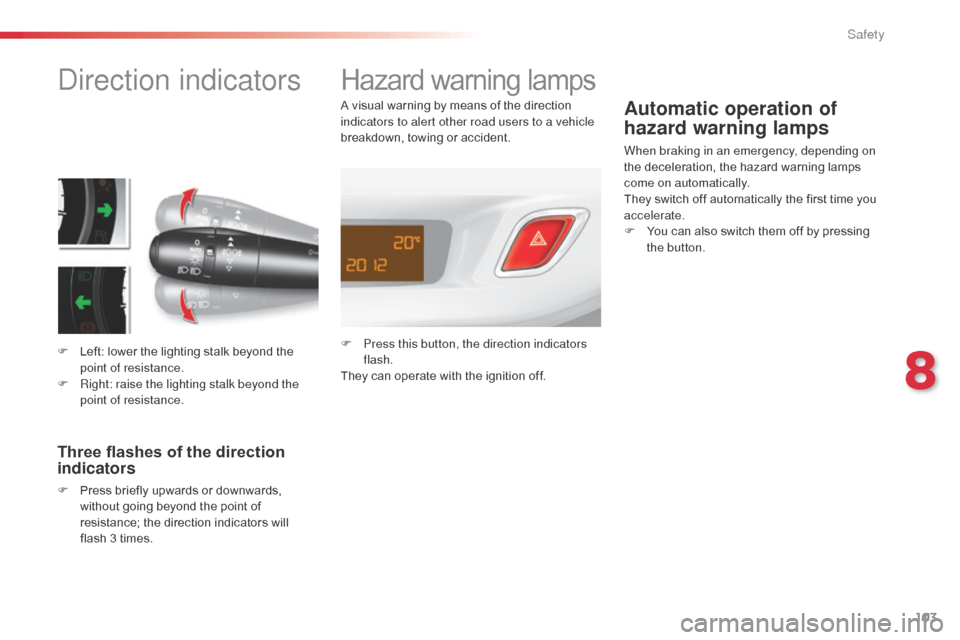
103
direction indicators
F Left: lower the lighting stalk beyond the point of resistance.
F
R
ight: raise the lighting stalk beyond the
point of resistance.
Three flashes of the direction
indicators
F Press briefly upwards or downwards, without going beyond the point of
resistance; the direction indicators will
flash 3 times.
Hazard warning lamps
F Press this button, the direction indicators flash.
They can operate with the ignition off.
Automatic operation of
hazard warning lamps
When braking in an emergency, depending on
the deceleration, the hazard warning lamps
come on automatically.
They switch off automatically the first time you
accelerate.
F
Y
ou can also switch them off by pressing
the button.
A visual warning by means of the direction
indicators to alert other road users to a vehicle
breakdown, towing or accident.
8
Safety
Page 114 of 401

112
The driver must ensure that passengers use
the seat belts correctly and that they are all
restrained securely before setting off.
Wherever you are seated in the vehicle,
always fasten your seat belt, even for short
journeys.
do n
ot interchange the seat belt buckles as
they will not fulfil their role fully.
The seat belts are fitted with an inertia reel
permitting automatic adjustment of the length
of the strap to your size. The seat belt is
stowed automatically when not in use.
be
fore and after use, ensure that the seat
belt is reeled in correctly.
The lower part of the strap must be
positioned as low as possible on the pelvis.
The upper part must be positioned in the
hollow of the shoulder.
The inertia reels are fitted with an automatic
locking device which comes into operation in
the event of a collision, emergency braking
or if the vehicle rolls over. You can release
the device by pulling the strap firmly and
then releasing it so that it reels in slightly.Recommendations for children
Use a suitable child seat if the passenger is
less than 12 years old or shorter than one
and a half metres.
ne
ver use the same seat belt to secure more
than one person.
Never allow a child to travel on your lap.
For more information, refer to the "Child
seats" section.
In order to be effective, a seat belt must:
-
b
e tightened as close to the body as
possible,
-
b
e pulled in front of you with a smooth
movement, checking that it does not
twist,
-
b
e used to restrain only one person,
-
n
ot bear any trace of cuts or fraying,
-
n
ot be converted or modified to avoid
affecting its performance.
In accordance with current safety
regulations, for all repairs on your vehicle's
seat belts, go to a qualified workshop with
the skills and equipment needed, which a
CITR
oËn
dealer is able to provide.
Have your seat belts checked regularly by
a CITROËN dealer or a qualified workshop,
particularly if the straps show signs of
damage.
Clean the seat belt straps with soapy
water or a textile cleaning product, sold by
CITR
oËn d
ealers.
af
ter folding or moving a seat or rear bench
seat, ensure that the seat belt is positioned
and reeled in correctly.
In the event of an impact
Depending on the nature and seriousness
of the impact , the pretensioning device may
be deployed before and independently of the
airbags.
d
ep
loyment of the pretensioners
is accompanied by a slight discharge of
harmless smoke and a noise, due to the
activation of the pyrotechnic cartridge
incorporated in the system.
In all cases, the airbag warning lamp comes
on.
Following an impact, have the seat belts
system checked, and if necessary replaced,
by a CITR
oËn
dealer or a qualified
workshop.
Safety
Page 115 of 401
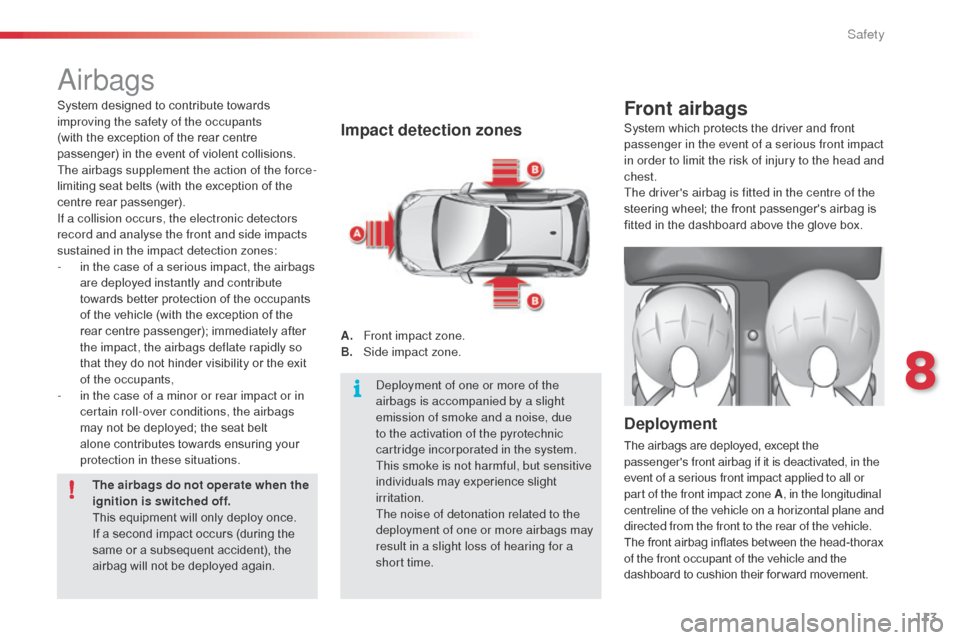
113
airbags
Impact detection zones
A. Front impact zone.
B. Side impact zone.
Front airbags
Deployment
The airbags are deployed, except the
passenger's front airbag if it is deactivated, in the
event of a serious front impact applied to all or
part of the front impact zone A , in the longitudinal
centreline of the vehicle on a horizontal plane and
directed from the front to the rear of the vehicle.
The front airbag inflates between the head-thorax
of the front occupant of the vehicle and the
dashboard to cushion their for ward movement.
System designed to contribute towards
improving the safety of the occupants
(with the exception of the rear centre
passenger) in the event of violent collisions.
The airbags supplement the action of the force-
limiting seat belts (with the exception of the
centre rear passenger).
If a collision occurs, the electronic detectors
record and analyse the front and side impacts
sustained in the impact detection zones:
-
i
n the case of a serious impact, the airbags
are deployed instantly and contribute
towards better protection of the occupants
of the vehicle (with the exception of the
rear centre passenger); immediately after
the impact, the airbags deflate rapidly so
that they do not hinder visibility or the exit
of the occupants,
-
i
n the case of a minor or rear impact or in
certain roll-over conditions, the airbags
may not be deployed; the seat belt
alone contributes towards ensuring your
protection in these situations.
The airbags do not operate when the
ignition is switched off.
de
ployment of one or more of the
airbags is accompanied by a slight
emission of smoke and a noise, due
to the activation of the pyrotechnic
cartridge incorporated in the system.
This smoke is not harmful, but sensitive
individuals may experience slight
irritation.
The noise of detonation related to the
deployment of one or more airbags may
result in a slight loss of hearing for a
short time. System which protects the driver and front
passenger in the event of a serious front impact
in order to limit the risk of injury to the head and
chest.
The driver's airbag is fitted in the centre of the
steering wheel; the front passenger's airbag is
fitted in the dashboard above the glove box.
This equipment will only deploy once.
If a second impact occurs (during the
same or a subsequent accident), the
airbag will not be deployed again.
8
Safety
Page 117 of 401
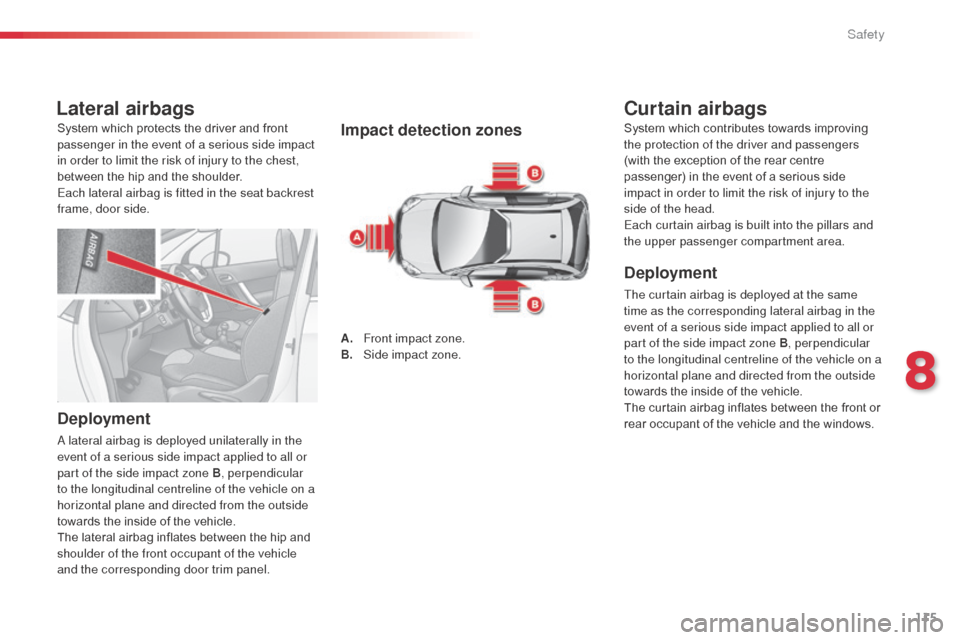
115
Lateral airbags
Deployment
a lateral airbag is deployed unilaterally in the
e vent of a serious side impact applied to all or
part of the side impact zone B, perpendicular
to the longitudinal centreline of the vehicle on a
horizontal plane and directed from the outside
towards the inside of the vehicle.
The lateral airbag inflates between the hip and
shoulder of the front occupant of the vehicle
and the corresponding door trim panel.
Impact detection zones
A. Front impact zone.
B. S ide impact zone.
Curtain airbags
Deployment
The curtain airbag is deployed at the same
time as the corresponding lateral airbag in the
event of a serious side impact applied to all or
part of the side impact zone B, perpendicular
to the longitudinal centreline of the vehicle on a
horizontal plane and directed from the outside
towards the inside of the vehicle.
The curtain airbag inflates between the front or
rear occupant of the vehicle and the windows.
System which protects the driver and front
passenger in the event of a serious side impact
in order to limit the risk of injury to the chest,
between the hip and the shoulder.
Each lateral airbag is fitted in the seat backrest
frame, door side.
System which contributes towards improving
the protection of the driver and passengers
(with the exception of the rear centre
passenger) in the event of a serious side
impact in order to limit the risk of injury to the
side of the head.
Each curtain airbag is built into the pillars and
the upper passenger compartment area.
8
Safety
Page 122 of 401
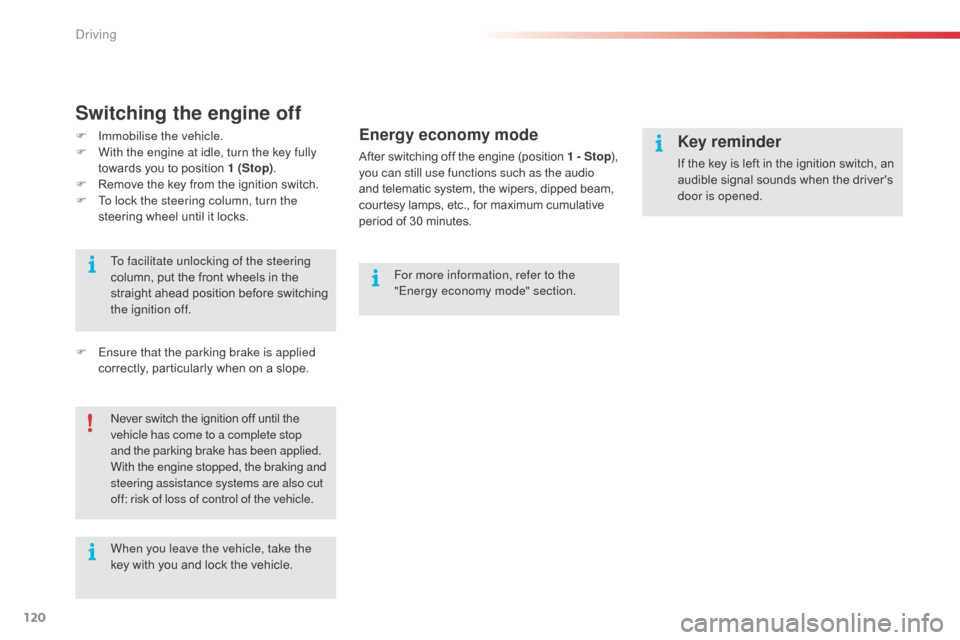
120
Switching the engine off
F Immobilise the vehicle.
F W ith the engine at idle, turn the key fully
towards you to position 1 (Stop) .
F
R
emove the key from the ignition switch.
F
T
o lock the steering column, turn the
steering wheel until it locks.
Never switch the ignition off until the
vehicle has come to a complete stop
and the parking brake has been applied.
With the engine stopped, the braking and
steering assistance systems are also cut
off: risk of loss of control of the vehicle. To facilitate unlocking of the steering
column, put the front wheels in the
straight ahead position before switching
the ignition off.
When you leave the vehicle, take the
key with you and lock the vehicle.Key reminder
If the key is left in the ignition switch, an
audible signal sounds when the driver's
door is opened.
For more information, refer to the
"Energy economy mode" section.
F
E
nsure that the parking brake is applied
correctly, particularly when on a slope.
Energy economy mode
After switching off the engine (position 1 - Stop ),
you can still use functions such as the audio
and telematic system, the wipers, dipped beam,
courtesy lamps, etc., for maximum cumulative
period of 30 minutes.
Driving
Page 132 of 401
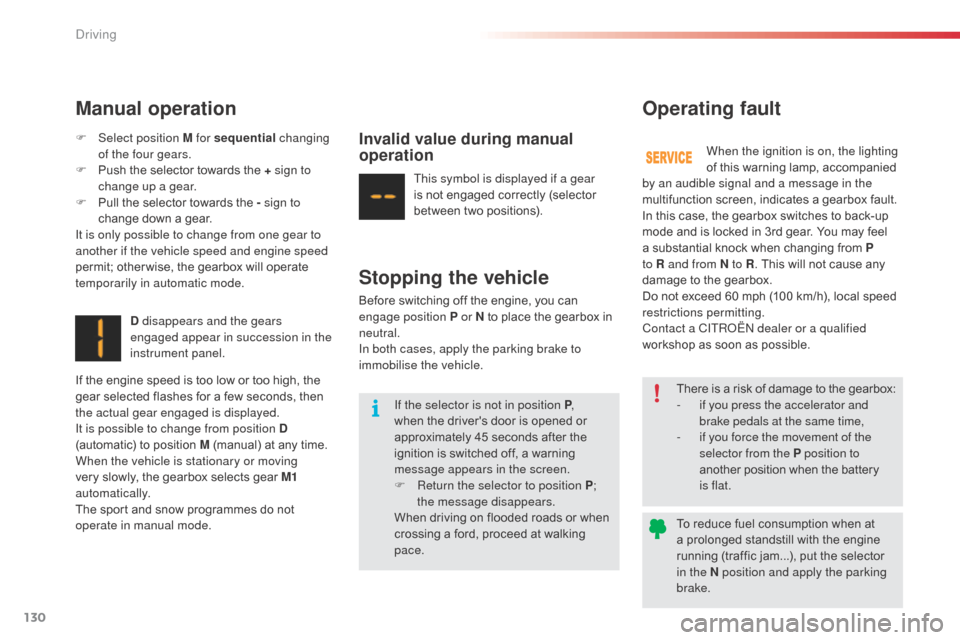
130
Manual operation
F Select position M for sequential changing
of the four gears.
F
P
ush the selector towards the + sign to
change up a gear.
F
P
ull the selector towards the - sign to
change down a gear.
It is only possible to change from one gear to
another if the vehicle speed and engine speed
permit; other wise, the gearbox will operate
temporarily in automatic mode.
D disappears and the gears
engaged appear in succession in the
instrument panel.
If the engine speed is too low or too high, the
gear selected flashes for a few seconds, then
the actual gear engaged is displayed.
It is possible to change from position D
(automatic) to position M (manual) at any time.
When the vehicle is stationary or moving
very slowly, the gearbox selects gear M1
automatically.
The sport and snow programmes do not
operate in manual mode.Invalid value during manual
operation
This symbol is displayed if a gear
is not engaged correctly (selector
between two positions).
Stopping the vehicle
Before switching off the engine, you can
engage position P or N to place the gearbox in
neutral.
In both cases, apply the parking brake to
immobilise the vehicle.
If the selector is not in position P ,
when the driver's door is opened or
approximately 45 seconds after the
ignition is switched off, a warning
message appears in the screen.
F
R
eturn the selector to position P ;
the message disappears.
When driving on flooded roads or when
crossing a ford, proceed at walking
pace. When the ignition is on, the lighting
of this warning lamp, accompanied
by an audible signal and a message in the
multifunction screen, indicates a gearbox fault.
In this case, the gearbox switches to back-up
mode and is locked in 3rd gear. You may feel
a substantial knock when changing from P
to R and from N to R . This will not cause any
damage to the gearbox.
Do not exceed 60 mph (100 km/h), local speed
restrictions permitting.
Contact a CITR
oËn
dealer or a qualified
workshop as soon as possible.
Operating fault
There is a risk of damage to the gearbox:
- i f you press the accelerator and
brake pedals at the same time,
-
i
f you force the movement of the
selector from the P position to
another position when the battery
is
flat.
To reduce fuel consumption when at
a prolonged standstill with the engine
running (traffic jam...), put the selector
in the N position and apply the parking
brake.
Driving
Page 143 of 401
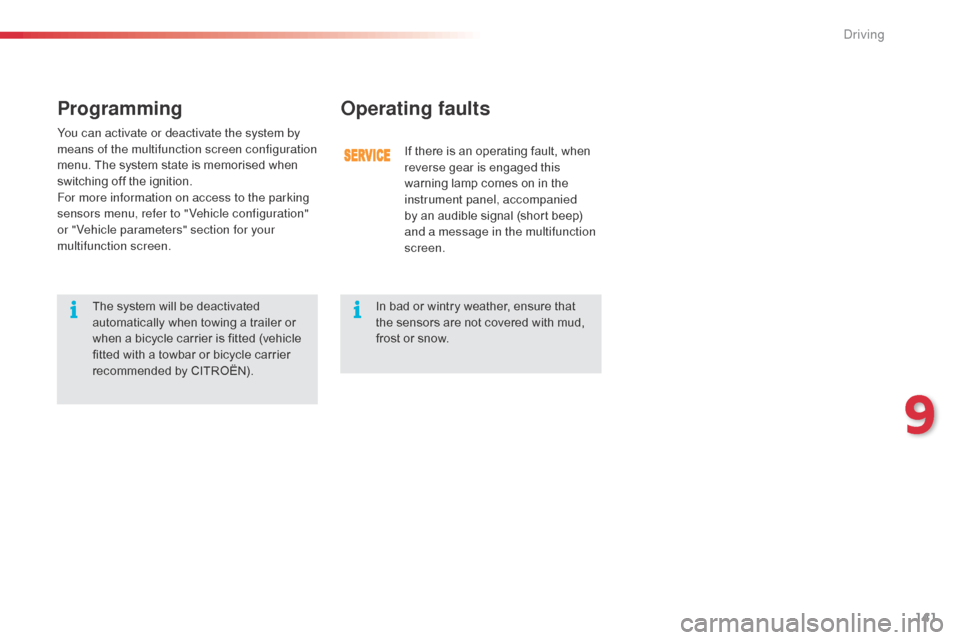
141
You can activate or deactivate the system by
means of the multifunction screen configuration
menu. The system state is memorised when
switching off the ignition.
For more information on access to the parking
sensors menu, refer to " Vehicle configuration"
or " Vehicle parameters" section for your
multifunction screen.
Operating faults
If there is an operating fault, when
reverse gear is engaged this
warning lamp comes on in the
instrument panel, accompanied
by an audible signal (short beep)
and a message in the multifunction
screen.
Programming
The system will be deactivated
automatically when towing a trailer or
when a bicycle carrier is fitted (vehicle
fitted with a towbar or bicycle carrier
recommended by CITROËN).In bad or wintry weather, ensure that
the sensors are not covered with mud,
frost or snow.
9
driving